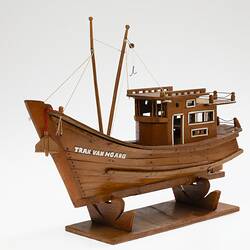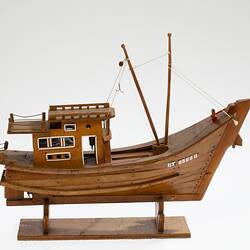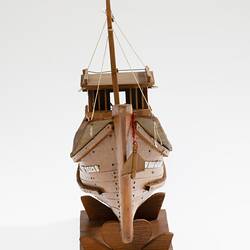Summary
Wooden model fishing boat made by Vietnamese refugee Tran van Hoang while waiting to be processed in Pulau Bidong Refugee Camp in Malaysia in 1981. He presented the boat to Lachlan Kennedy, a member of the Australian Department of Immigration Indo-Chinese Refugee Taskforce, from January-September 1981.
Hoang first gave the boat to Lachlan upon his arrival in Pulau Bidong as a gift of appreciation but Lachlan returned the gift quickly when he was subsequently assigned Hoang's case file by the UNHCR for processing. After the application was completed and accepted, Hoang later re-presented Lachlan with the boat, which he brought home with him to Australia and kept as a memento. Hoang, along with other refugees had been previously accepted by Canada but when Canada decided to refuse entry to all refugees with tuberculosis, they were left stranded. Australia agreed to re-assess them and Hoang was amongst those accepted on condition of a prolonged period of treatment and recovery.
These boat models were not uncommon and this one was a gift to Lachlan who brought it home with him to Australia (along with a second model boat) and he gave it to his sister as a memento. Refugees had art workshops in the camps, which catered to this wide spread interest by making handcrafts. Sungai Besi had a reputation for producing quality models of Vietnamese fishing boats of the kind used by refugees to escape Vietnam.
Manual activity was prolific in the camps, with people making items (often from recycled materials) needed by the camp residents. Some of the camps in northern Thailand had small 'gift shops' where immigration staff, visiting officials, or interview teams could purchase items. In these camps people plied their trades as best they could, utilising their expertise in such activities as gold and silver jewellery making, gemstone setting, wooden furniture making, hairdressing, dressmaking and tailoring, drawing and painting, and weaving (by Lao and Khmer refugees).
Physical Description
Wooden model fishing boat with a cabin containing a wheel, masts and string fishing lines, a till and metal propellor at rear. The boat sits on a wooden detachable stand. There is white plastic lettering spelling the name of the ship. Small tacks and glue used to build the model and adhere the letters.
Significance
This important collection represents two sides of the asylum experience - the refugees and the government officials. These parallel and intersecting experiences have both personal and bureaucratic elements to them, linked by place, and world events, with craft and gifts of appreciation providing tangible points of connection and memory. The experiences of migration officials are frequently untold and unrepresented by material culture, as are material manifestations of refugee narratives. This collection enables the telling of both stories, with primacy given in this instance to the employee as custodian of the objects. The collection is also a symbol of a particular period in Australian migration history when support for refugee programs had both bipartisan and public support. Finally the theme of refugee, internee and detainee craft recurs across time and place and provides a tangible connection between very different human experiences, the trauma, economy and the tedium of which has been consistently alleviated through artistic practice.
More Information
-
Collecting Areas
-
Acquisition Information
Donation from Mr Lachlan Kennedy, 13 Dec 2014
-
Recipient
-
Classification
Migration, Processing - immigration selection, Refugee camps
-
Category
-
Discipline
-
Type of item
-
Overall Dimensions
450 mm (Length), 124 mm (Width), 200 mm (Height)
Height with mast repaired: 320 mm.
-
Overall Dimensions
300 mm (Length), 120 mm (Depth), 70 mm (Height)
Dimensions for stand.
-
Keywords
Vietnamese Immigration, Refugees, Crafts, Water Transport, Water Vessel, Boats, Model Boats, Models & Modelmaking, Art, Artistic Practices, Immigration, Immigrant Voyages, Immigration Selection, Vietnam War Refugees, Tuberculosis, Modelmaking







